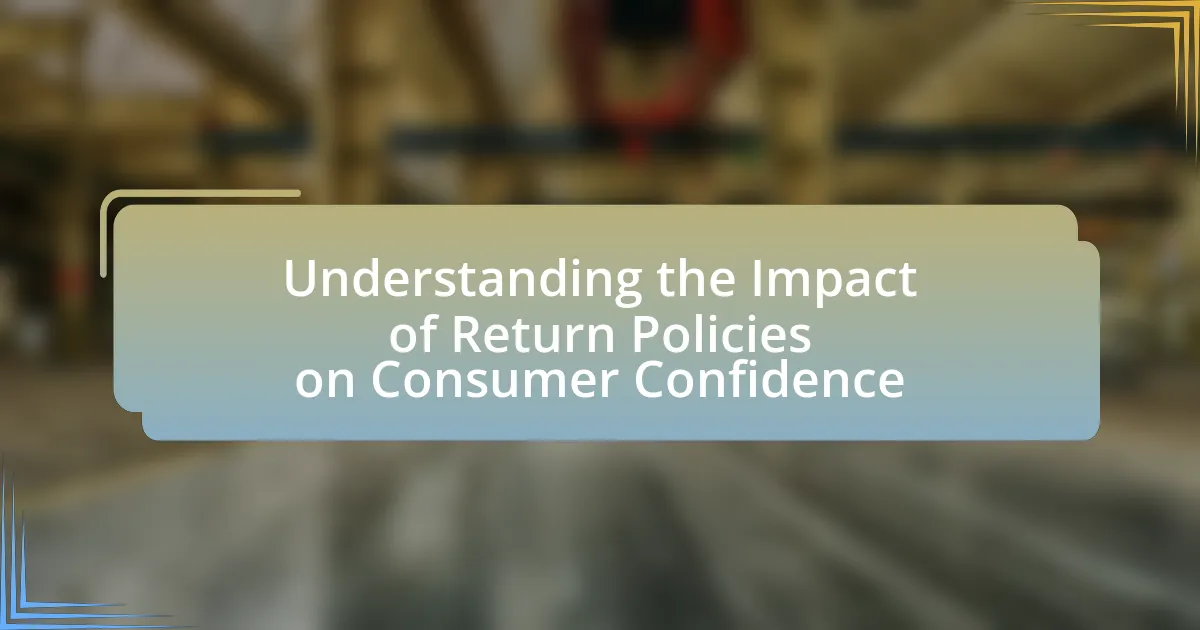The article analyzes the impact of payment options on consumer satisfaction, highlighting the significance of diverse payment methods in enhancing convenience and flexibility for consumers. Research indicates that a majority of consumers are more likely to complete purchases when multiple payment options are available, which reduces friction during checkout and increases overall satisfaction. The article discusses how different payment methods influence consumer choices, the most common options available, and the perceived security associated with these methods. Additionally, it explores the relationship between consumer satisfaction and brand loyalty, the role of payment flexibility, and the factors contributing to effective payment options, including demographic influences and psychological factors. Finally, the article outlines strategies for businesses to optimize payment options, ensuring security and enhancing consumer satisfaction.

What is the impact of payment options on consumer satisfaction?
The impact of payment options on consumer satisfaction is significant, as diverse payment methods enhance convenience and flexibility for consumers. Research indicates that 56% of consumers are more likely to complete a purchase when multiple payment options are available, according to a study by PayPal. This variety allows consumers to choose their preferred payment method, reducing friction during the checkout process and increasing overall satisfaction. Furthermore, offering options such as digital wallets, credit cards, and buy-now-pay-later services caters to different consumer preferences, which can lead to higher retention rates and repeat purchases.
How do different payment options influence consumer choices?
Different payment options significantly influence consumer choices by affecting convenience, perceived security, and overall satisfaction. For instance, studies show that consumers are more likely to complete a purchase when offered multiple payment methods, such as credit cards, digital wallets, and buy-now-pay-later options. Research by the Federal Reserve indicates that 40% of consumers prefer using debit or credit cards for their transactions due to the ease of use and security features associated with these methods. Furthermore, a survey conducted by PayPal revealed that 56% of consumers abandon their shopping carts if their preferred payment option is not available, highlighting the critical role payment flexibility plays in consumer decision-making.
What are the most common payment options available to consumers?
The most common payment options available to consumers include credit cards, debit cards, digital wallets, bank transfers, and cash. Credit cards are widely used due to their convenience and ability to offer rewards, with over 70% of consumers in the U.S. using them for online purchases. Debit cards provide direct access to bank funds and are favored for their simplicity. Digital wallets, such as PayPal and Apple Pay, have gained popularity for their speed and security, with a significant increase in usage reported during the pandemic. Bank transfers are often used for larger transactions, while cash remains a traditional option, particularly for in-person purchases. These payment methods collectively influence consumer satisfaction by providing flexibility and security in transactions.
How do consumers perceive the security of various payment methods?
Consumers generally perceive the security of payment methods based on their familiarity and the perceived risk associated with each option. Research indicates that traditional methods like credit cards are often viewed as more secure due to established fraud protection policies, with 70% of consumers expressing confidence in their security features. In contrast, newer methods such as mobile wallets and cryptocurrencies are perceived as less secure, primarily due to concerns about hacking and lack of regulation, with only 40% of users feeling secure using these options. This perception is influenced by factors such as media coverage of security breaches and personal experiences, which shape consumer trust in specific payment methods.
Why is consumer satisfaction important in the context of payment options?
Consumer satisfaction is crucial in the context of payment options because it directly influences customer loyalty and repeat business. When consumers have access to diverse and convenient payment methods, they are more likely to complete transactions and return for future purchases. Research indicates that 70% of consumers abandon their carts due to limited payment options, highlighting the importance of offering flexibility to enhance satisfaction. Furthermore, satisfied customers are more likely to recommend a business, thereby increasing its market reach and profitability.
How does consumer satisfaction affect brand loyalty?
Consumer satisfaction directly enhances brand loyalty by fostering positive emotional connections and repeat purchasing behavior. When consumers are satisfied with a product or service, they are more likely to develop trust and preference for that brand, leading to increased loyalty. Research indicates that satisfied customers are 60-70% more likely to repurchase from the same brand, as highlighted in a study by the Harvard Business Review, which emphasizes the correlation between satisfaction and loyalty metrics. This relationship underscores the importance of meeting consumer expectations to cultivate long-term brand allegiance.
What role does payment flexibility play in consumer satisfaction?
Payment flexibility significantly enhances consumer satisfaction by accommodating diverse financial situations and preferences. When consumers have the option to choose payment methods that suit their needs, such as installment plans or various digital payment options, they experience reduced financial stress and increased convenience. Research indicates that 70% of consumers prefer businesses that offer multiple payment options, highlighting the direct correlation between payment flexibility and customer contentment. This adaptability not only fosters loyalty but also encourages repeat purchases, as satisfied consumers are more likely to return to businesses that prioritize their financial preferences.

What factors contribute to the effectiveness of payment options?
The effectiveness of payment options is primarily influenced by convenience, security, transaction speed, and user experience. Convenience ensures that payment methods are easily accessible and user-friendly, which can significantly enhance consumer satisfaction. Security is critical, as consumers need to trust that their financial information is protected; studies show that 60% of consumers abandon transactions due to security concerns. Transaction speed affects the overall efficiency of the purchasing process; faster transactions lead to higher satisfaction rates. Lastly, a positive user experience, including clear interfaces and support for multiple payment methods, contributes to the overall effectiveness of payment options, as evidenced by research indicating that 70% of consumers prefer businesses that offer diverse payment methods.
How do demographic factors influence payment option preferences?
Demographic factors significantly influence payment option preferences by shaping consumer behavior based on age, income, education, and geographic location. For instance, younger consumers tend to prefer digital payment methods such as mobile wallets and contactless payments, while older demographics may favor traditional methods like cash or credit cards. Additionally, higher-income individuals often exhibit a preference for premium payment options that offer rewards or benefits, whereas lower-income consumers may prioritize payment methods that minimize fees. Research from the Federal Reserve indicates that 79% of adults aged 18-29 use mobile payment apps, compared to only 24% of those aged 60 and above, highlighting the stark differences in preferences across age groups.
What payment options are preferred by different age groups?
Younger consumers, particularly those aged 18-24, prefer digital payment options such as mobile wallets and contactless payments, while older age groups, like those aged 55 and above, tend to favor traditional methods like credit cards and cash. A study by the Federal Reserve in 2021 indicated that 60% of younger adults use mobile payment apps, compared to only 20% of older adults, who predominantly rely on credit cards (40%) and cash (30%). This trend highlights the generational divide in payment preferences, influenced by technology adoption and comfort levels with digital transactions.
How does income level affect payment method choices?
Income level significantly influences payment method choices, as higher-income individuals tend to prefer credit cards and digital payment options, while lower-income individuals often rely on cash or debit cards. Research indicates that consumers with higher incomes are more likely to utilize credit cards due to benefits such as rewards programs and the ability to manage cash flow, whereas those with lower incomes may prioritize immediate payment methods to avoid debt. A study by the Federal Reserve in 2020 found that 40% of low-income households primarily use cash for transactions, compared to only 10% of high-income households, highlighting the correlation between income level and payment preferences.
What psychological factors impact consumer satisfaction with payment options?
Psychological factors that impact consumer satisfaction with payment options include perceived ease of use, trust, and perceived value. Perceived ease of use refers to how simple and intuitive the payment process is; studies show that consumers are more satisfied when payment methods are straightforward and require minimal effort. Trust is crucial, as consumers need to feel secure when providing personal and financial information; research indicates that higher trust levels correlate with increased satisfaction. Lastly, perceived value encompasses the benefits consumers believe they receive from using a particular payment option, such as rewards or discounts, which can enhance their overall satisfaction. These factors collectively influence consumer behavior and satisfaction levels in the context of payment options.
How does the ease of use of payment methods affect consumer satisfaction?
The ease of use of payment methods significantly enhances consumer satisfaction. When payment processes are straightforward and user-friendly, consumers experience less frustration and greater convenience, leading to a more positive overall shopping experience. Research indicates that 70% of consumers abandon their purchases due to complicated payment processes, highlighting the direct correlation between ease of payment and consumer retention. Furthermore, studies show that businesses offering seamless payment options, such as one-click payments or mobile wallets, report higher customer satisfaction scores and increased loyalty.
What emotional responses do consumers have towards different payment options?
Consumers exhibit varied emotional responses towards different payment options, influenced by factors such as convenience, security, and familiarity. For instance, credit card payments often evoke feelings of trust and security due to established consumer protections, while digital wallets may generate excitement and satisfaction due to their speed and ease of use. Conversely, cash payments can lead to anxiety in situations where change is required or when digital options are preferred. Research indicates that 60% of consumers feel more satisfied when using payment methods that they perceive as secure, highlighting the emotional impact of perceived safety on consumer choices.

How can businesses optimize payment options to enhance consumer satisfaction?
Businesses can optimize payment options to enhance consumer satisfaction by offering a variety of payment methods, ensuring security, and streamlining the checkout process. Providing multiple payment options, such as credit cards, digital wallets, and buy-now-pay-later services, caters to diverse consumer preferences and increases the likelihood of completed transactions. Research indicates that 56% of consumers abandon their carts due to limited payment options, highlighting the importance of variety in enhancing satisfaction. Additionally, implementing secure payment gateways builds trust, as 86% of consumers are concerned about online payment security. Finally, simplifying the checkout process by minimizing steps and reducing required information can lead to a 30% increase in conversion rates, further improving consumer satisfaction.
What strategies can businesses implement to improve payment options?
Businesses can implement multiple strategies to improve payment options, including offering diverse payment methods, enhancing mobile payment capabilities, and ensuring secure transactions. By providing various payment methods such as credit cards, digital wallets, and buy-now-pay-later options, businesses cater to different consumer preferences, which can increase conversion rates. Enhancing mobile payment capabilities, such as integrating with popular apps like Apple Pay or Google Pay, allows for a seamless checkout experience, which is crucial as mobile commerce continues to grow. Additionally, ensuring secure transactions through encryption and compliance with standards like PCI DSS builds consumer trust, as 60% of consumers abandon purchases due to security concerns. These strategies collectively enhance consumer satisfaction by making the payment process more convenient and secure.
How can businesses assess consumer preferences for payment methods?
Businesses can assess consumer preferences for payment methods by conducting surveys and analyzing transaction data. Surveys can directly gather consumer feedback on preferred payment options, while transaction data reveals actual usage patterns. For instance, a study by the Federal Reserve in 2021 indicated that 79% of consumers preferred debit or credit cards for transactions, highlighting the importance of these methods. Additionally, businesses can utilize A/B testing to evaluate consumer responses to different payment options in real-time, providing further insights into preferences.
What role does technology play in enhancing payment options?
Technology significantly enhances payment options by enabling faster, more secure, and diverse transaction methods. Innovations such as mobile wallets, contactless payments, and blockchain technology streamline the payment process, allowing consumers to complete transactions quickly and conveniently. For instance, a study by the Federal Reserve in 2021 indicated that 43% of consumers used mobile payment apps, reflecting a growing preference for digital solutions. Additionally, advancements in encryption and tokenization improve security, reducing fraud risk and increasing consumer trust in digital payments. These technological developments not only cater to consumer preferences for convenience but also contribute to overall satisfaction by providing a seamless payment experience.
What best practices should businesses follow regarding payment options?
Businesses should offer a diverse range of payment options to enhance consumer satisfaction. Providing multiple payment methods, such as credit cards, digital wallets, and bank transfers, caters to varying customer preferences and increases the likelihood of completing a sale. Research indicates that 56% of consumers abandon their carts due to limited payment options, highlighting the importance of flexibility in payment methods. Additionally, ensuring secure transactions through encryption and compliance with regulations builds trust, which is crucial for customer retention. By implementing these best practices, businesses can significantly improve the overall shopping experience and drive higher conversion rates.
How can businesses ensure the security of payment transactions?
Businesses can ensure the security of payment transactions by implementing robust encryption protocols and adhering to industry standards such as PCI DSS (Payment Card Industry Data Security Standard). Encryption protects sensitive data during transmission, making it difficult for unauthorized parties to access it. According to a 2021 report by Verizon, 81% of data breaches are due to weak or stolen passwords, highlighting the importance of strong authentication measures. Additionally, businesses should regularly update their security systems and conduct vulnerability assessments to identify and mitigate potential threats. By following these practices, businesses can significantly reduce the risk of fraud and enhance consumer trust in their payment processes.
What are the common pitfalls to avoid when offering payment options?
Common pitfalls to avoid when offering payment options include limiting the variety of payment methods, which can alienate potential customers. Research indicates that 56% of consumers abandon their carts due to a lack of preferred payment options. Additionally, failing to ensure security can lead to trust issues; 43% of consumers are concerned about online payment security. Not optimizing for mobile devices is another critical mistake, as mobile commerce accounts for over 50% of online transactions. Lastly, unclear pricing or hidden fees can frustrate customers, leading to decreased satisfaction and increased cart abandonment rates.
What are the future trends in payment options that may affect consumer satisfaction?
Future trends in payment options that may affect consumer satisfaction include the rise of contactless payments, digital wallets, and cryptocurrency integration. Contactless payments, which have surged by 150% in 2020 alone, enhance convenience and speed, leading to higher consumer satisfaction. Digital wallets, such as Apple Pay and Google Wallet, are projected to account for over 50% of all e-commerce transactions by 2025, providing users with seamless transaction experiences. Additionally, the increasing acceptance of cryptocurrencies, with over 15,000 businesses now accepting Bitcoin, offers consumers more flexibility and choice in payment methods, further enhancing satisfaction. These trends indicate a shift towards faster, more secure, and user-friendly payment solutions that align with consumer preferences.





